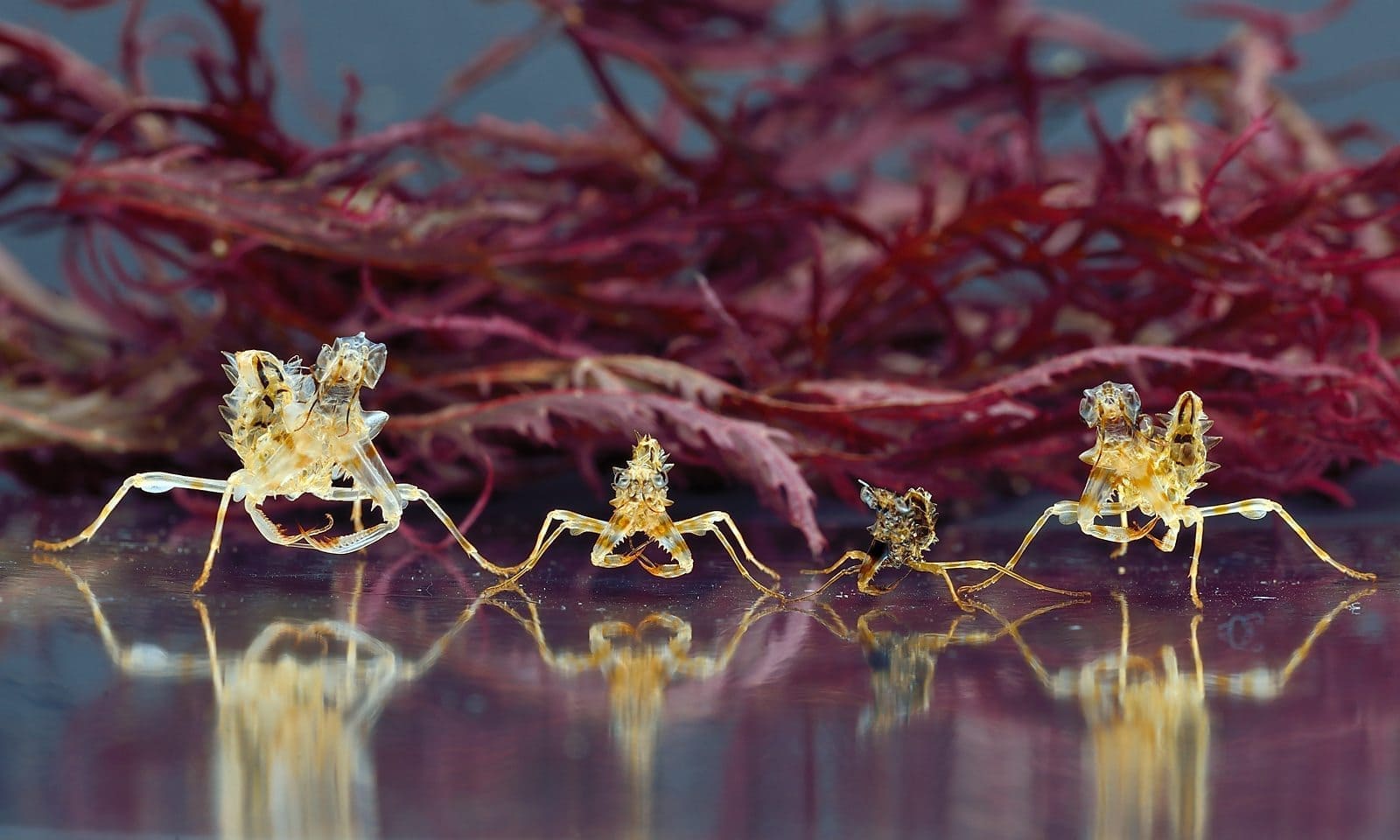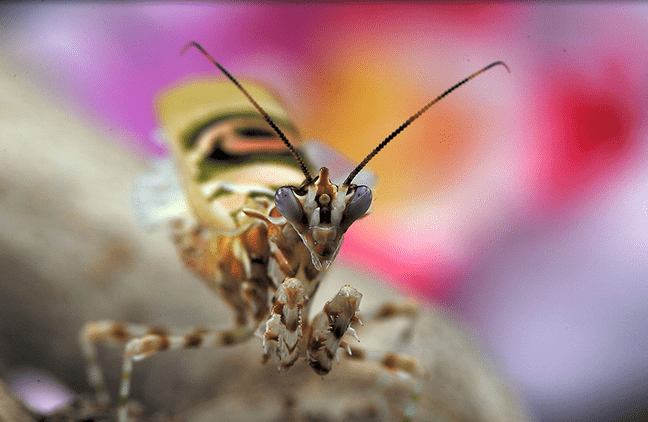General:
Pseudocreobotra wahlbergii also called African flower mantis camouflages as a flower like all of its species. The basic color is a pinkish white with a broad green banding on the segments. It also has green bands or spots on its chest (thorax) and head as well as on its legs. I love this species of mantid. It is easy to keep, and its visual appearance is right up my alley. An exciting experiment that you can just try is to change the color of the mantis’s environment. It can adapt to its environment after each molt. So it can be colored blue, white, purple or green. Just try it and write me your results in the comments. Their lobe-like outgrowths on both sides of their abdomen look like petals. On the wings are yellow-green-black eye markings which she shows when she feels threatened. They are shaped like the number 6 or 9, depending on how you look at them. In subadults, which do not have fully developed wings, there is an eye marking on the abdomen instead. They respond to threats by raising the abdomen.
The eyes of the flower mantis have a slight blue-violet sheen.
Size:
Male: 3.0 cm – 4.0 cm
Females: 4.0 cm – 5.0 cm
Food:
L1/L2: Small fruit flies Drosophila melanogaster.
L3/L4: large fruit flies Drosophila hydei
L5/L6: goldflies Lucilia sericata
L7/adult: blowflies Calliphora sp.
Habitat:
The African flower mantis is found in eastern and southern Africa. It is known in Angola, Ethiopia, Kenya, Congo, Malawi, Mozambique, Tanzania including Zanzibar, Zambia, Zimbabwe and Transvaal where it inhabits moist areas such as meadows or shrubs and especially flowers. It lurks on the underside or upper side of flowers for nectar-seeking insects. The size of their habitat underlines again the not too difficult keeping conditions. The climatic conditions in these countries are, a relatively high temperature during the day from 28-35°C with a nightly drop to 23°C. Do not go below 20°C for this species, as they are very sensitive to cold and will die if the temperature is permanently too low. Humidity is around 30-50% during the day and at night it increases to 60-80%.
Pic: © Ralf Bauer
Keeping in the insectarium:
L1-L3
Pseudocreobotra wahlbergii have a high aggresivity towards conspecifics. Therefore I separate them immediately after hatching. This way the animals have less stress and also grow faster and there is no danger that they will be eaten by their conspecifics. I keep them in a 500 g/ml packing cup. There I cut out an opening in the lid and flushed a ladies stocking under it and put a ventilation on the side. I use wood shavings for climbing and kitchen towels for substrate, since they are cheap and hygienic. It is really important that you always leave twice the size of the mantids at the bottom, so that the moulting goes off without complications. In the evening spray the kitchen towel so that it is almost dry the next evening. I always offer them food in the form of drosophilas. Once a week the container is cleaned.
(L1 Pseudocreobotra wahlbergii, special thanks to Chase Campbell)
from L4:
I use BraPlast tins with dimensions 18.5×18.5×19.0cm. There should be branches and flowers there like in their natural environment. The mantis does not distinguish whether they are real flowers or plastic flowers. It can adapt its coloration to the environment. Here you can gather your own experience.
If you take branches from nature, put them in the microwave for 20 seconds or in the oven at 100°C for 15 minutes. This will kill all the mites and other parasites that can cause you problems later. Also there the motto is, less is more. Mantises are lurking hunters, you should not pack it full. Leave space for molting, as this moment is the most dangerous time in your guest’s life.
Reproduction:
Sexing:
First of all, we need to know what is a female and what is a male.
In all mantid species, females can be distinguished from males by the number of visible abdominal segments (sternites).
Males have 8 sternites, whereas females have only 6 visible ones. This can be seen with a magnifying glass often already from L3, from L4 and L5 it can be seen with the naked eye. Mostly it is enough to look only at the last segment on the abdomen. If it is as long and wide as the previous segments, it is a female. If the last segments become progressively smaller and narrower, it is a male. Note, in the adult stage the male also has an elongated last segment.
In the subadult larval stage you can also recognize the males of this species by the thickened and longer antennae.
Sexual maturity:
Females become adults after about 7 molts, thus in L8. Males after 6 molts, thus in L7. Females take 4 weeks to become ready to mate after the mature molt. Males only 1 week.
This means males become sexually mature one molt and three weeks before. This is a feasible time frame since males live about 2.5 months after the mature molt.
The sex difference can be recognized from L3 on. So you can keep the males a bit cooler than the females as a preventive measure. Please remember, do not go below 20°C.
So about 4 weeks after the mature moult the animals are ready to mate.

Mating:
A special behavior of both sexes is flapping their wings for minutes without flying off. What this is intended for is still unclear, but it could serve to distribute released pheromones in the air.
Due to the big difference between the readiness to mate, one should keep the male a little cooler than the female until the female is ready. To do this, put the female in the terrarium from the male, as this will cause less stress to the males. The female should be fed sufficiently before copulation, also you can offer the female something to eat during mating. Now it depends on the female how the whole thing ends. It can happen that the female attacks and eats the male before mating, but of course it is also possible that the male makes it onto the female’s back. If the male is interested in the female he usually flies immediately onto the female’s back. It often happens that you have to stimulate the male with up to 40°C and put him directly behind the female. Some males court with their wings up, others do not. In the beginning it can happen that it sits on the back but does not copulate for days. After the third day it should be separated again to feed the male. The copulation itself takes about 4 to 7 hours. If the female attacks the male and eats the head, mating can still take place. If the male makes it down from his back after mating, he can be returned to his terrarium. The female then starts to lay the first of four to eight oothecae after about 4 to 10 days. At intervals of 7 to 14 days the remaining oothecae are built. The size can be up to 5 centimeters, the appearance is dark and very narrow.
I always mate the animals in the insectarium of the males. It should be noted that the males are good and also agile flyers. Before that I give the female a big food animal, so that she is busy with eating during the mating and does not attack the male. This reduces sexual cannibalism and at the same time provides better ootheca. Mating proceeds as follows. The male jumps on the female’s back while holding her with his front legs. Copulation can last up to 12 hours, so you can watch the spectacle at your leisure.
Ootheca deposition:
The female begins building oothecae after 4 days, at intervals of up to 10 days. Between 4 and 8, more rarely also more oothecae are built. The coloration of the ootheca is dark, black or brown and up to 5 centimeters very elongated and narrow. In contrast to the free ootheca of cockroaches, mantis shrimp adhere their roundish, elongate, shield-like, teardrop-shaped, or parcel-like ootheca to various substrates. They are often attached to climbing surfaces or to the gauze lid. To do this, they first apply a proteinaceous secretion to the substrate. Under spiral movements of the abdomen, more of this foamy secretion is now released, whereby the eggs are now deposited one after the other into the same in such a way that they are in a certain arrangement to each other and occupy one compartment of the ootheca each. Finally, the secretion is drawn out in a more or less long thread before it hardens into a sponge-like, very firm cocoon. Along the surface lies the thinnest-walled area from which the nymphs hatch. It can usually be seen as a large-pored, seam- or comb-like strip. For more on the ootheca, click here.
Incubation:
Incubation of the ootheca should be done between 30-40°C, also you should reach a humidity of up to 70%. After 4-7 weeks between 20 and 80 larvae hatch out of the ootheca at the same time. At hatching they are shiny black and imitate ants.






